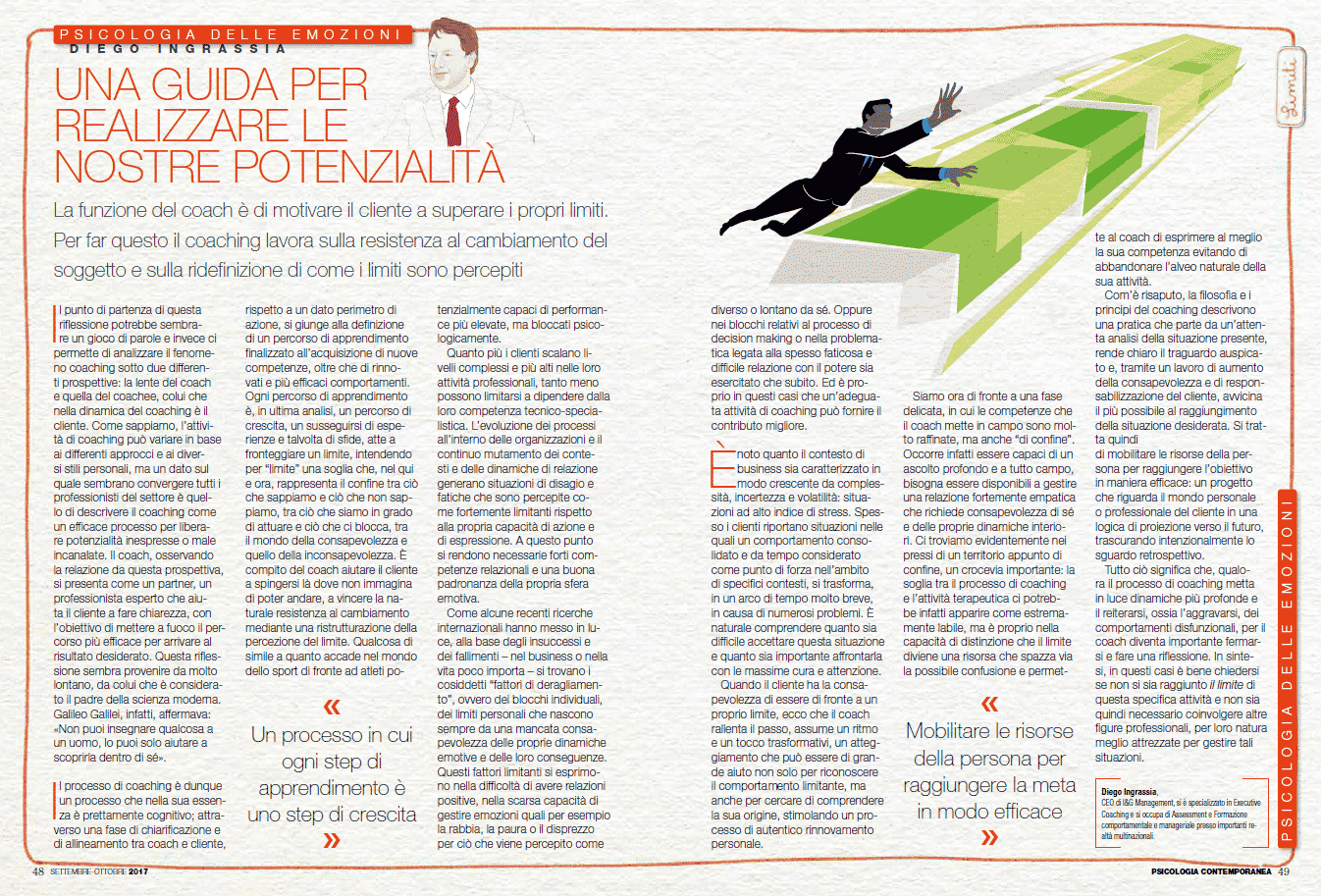
The secret language of emotions
22 March 2018
Resistance to change in organisations
22 March 2018A guide to realising our potential

Article by Diego Ingrassia – “A GUIDE TO REALISING OUR POTENTIALITY”
for PSICOLOGIA CONTEMPORANEA – Limits– no. 263, September-October 2017 – GIUNTI EDITORE
The starting point of this reflection might seem like a play on words and instead allows us to analyse the coaching phenomenon under two different perspectives: the lens of the coach and that of the coachee, the one who in the coaching dynamic is the client.
As we know, coaching can vary according to different approaches and personal styles, but one fact on which all professionals in the field seem to converge is to describe coaching as an effective process for releasing unexpressed or badly channelled potential.
The coach, looking at the relationship from this perspective, presents himself as a partner, an experienced professional who helps the client to gain clarity, with the aim of focusing on the most effective path to the desired result.
This reflection seems to come from far away, from the man who is considered the father of modern science.
Galileo Galilei, in fact, stated: ‘You cannot teach a man something, you can only help him to discover it within himself’.
The coaching process is therefore a process that in its essence is purely cognitive; through a phase of clarification and alignment between coach and client, with respect to a given scope of action, a learning path is defined aimed at the acquisition of new skills, as well as renewed and more effective behaviour.
Every learning path is, in the final analysis, a path of growth, a succession of experiences and sometimes challenges, aimed at facing a limit, meaning by “limit” a threshold that, in the here and now, represents the boundary between what we know and what we do not know, between what we are able to implement and what blocks us, between the world of awareness and that of unawareness.
It is the coach’s task to help the client to go where he/she does not imagine he/she can go, to overcome the natural resistance to change through a restructuring of the perception of the boundary. Something similar to what happens in the world of sport when faced with athletes potentially capable of higher performance, but psychologically blocked.
The more clients scale complex and higher levels in their professional activities, the less they can rely on their technical expertise.
The evolution of processes within organisations and the ever-changing contexts and dynamics of relationships generate situations of discomfort and fatigue that are perceived as severely limiting one’s capacity for action and expression.
At this point, strong relational skills and a good command of one’s own emotional sphere become necessary.
As some recent international research has highlighted, at the basis of failures and failures – in business or in life, it matters little – are the so-called ‘derailing factors’, i.e. individual blocks, personal limits that always arise from a lack of awareness of one’s own emotional dynamics and their consequences.
These limiting factors are expressed in the difficulty of having positive relationships, in the poor ability to manage emotions such as anger, fear or contempt for what is perceived as different or distant from oneself.
Or in blockages related to the decision-making process or in the often tiring and difficult relationship with power both exercised and suffered.
And it is precisely in these cases that appropriate coaching can provide the best contribution.
It is well known how the business environment is increasingly characterised by complexity, uncertainty and volatility: situations with a high stress index.
Clients often report situations in which a well-established behaviour, long regarded as a strength in specific contexts, is transformed into the cause of numerous problems in a very short space of time.
It is natural to understand how difficult it is to accept this situation and how important it is to deal with it with the utmost care and attention.
When the client has the awareness of being faced with his or her own limitation, the coach slows down the pace, assumes a transformative rhythm and touch, an attitude that can be of great help not only in recognising the limiting behaviour, but also in trying to understand its origin, stimulating a process of authentic personal renewal. We are now facing a delicate phase, in which the coach’s skills are very refined, but also ‘borderline’.
In fact, it is necessary to be capable of deep and all-round listening, to be willing to manage a strongly empathic relationship that requires awareness of oneself and one’s inner dynamics.
We are evidently in borderline territory, an important crossroads: the threshold between the coaching process and therapeutic activity might appear extremely blurred, but it is precisely in the ability to distinguish that the limit becomes a resource that sweeps away possible confusion and allows the coach to express his or her competence to the fullest, avoiding abandoning the natural course of his or her activity.
As is well known, the philosophy and principles of coaching describe a practice that starts from a careful analysis of the present situation, makes the desired goal clear and, through a work of increasing the client’s awareness and empowerment, gets as close as possible to achieving the desired situation.
It is therefore a matter of mobilising the person’s resources to achieve the goal effectively: a project that concerns the client’s personal or professional world in a logic of projection towards the future, intentionally disregarding the retrospective view.
All this means that if the coaching process highlights deeper dynamics and the repetition, i.e. the worsening, of dysfunctional behaviour, it becomes important for the coach to stop and reflect.
In short, in these cases it is good to ask oneself whether the limit of this specific activity has not been reached and whether it is therefore necessary to involve other professional figures, who by their nature are better equipped to handle such situations.



